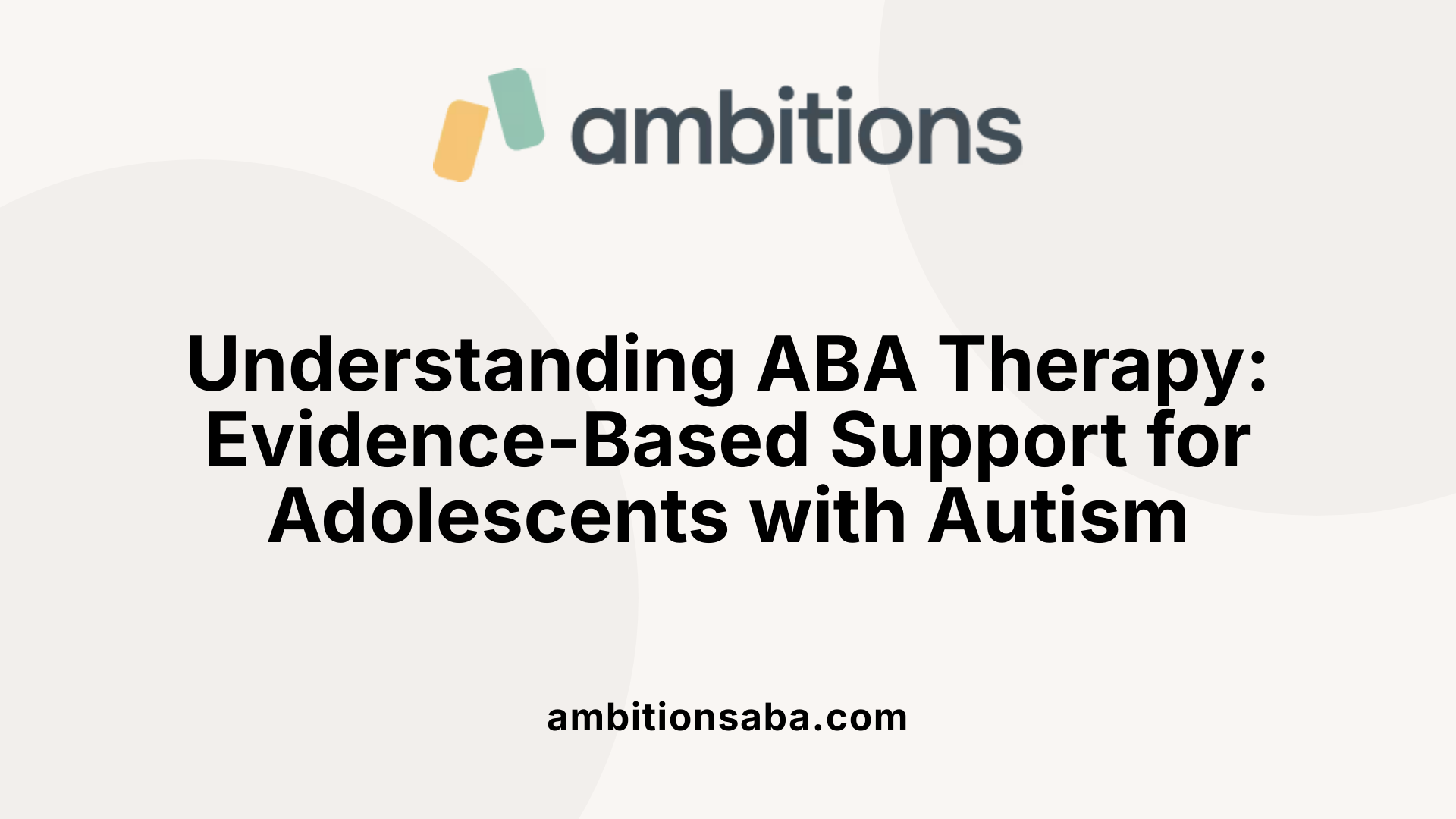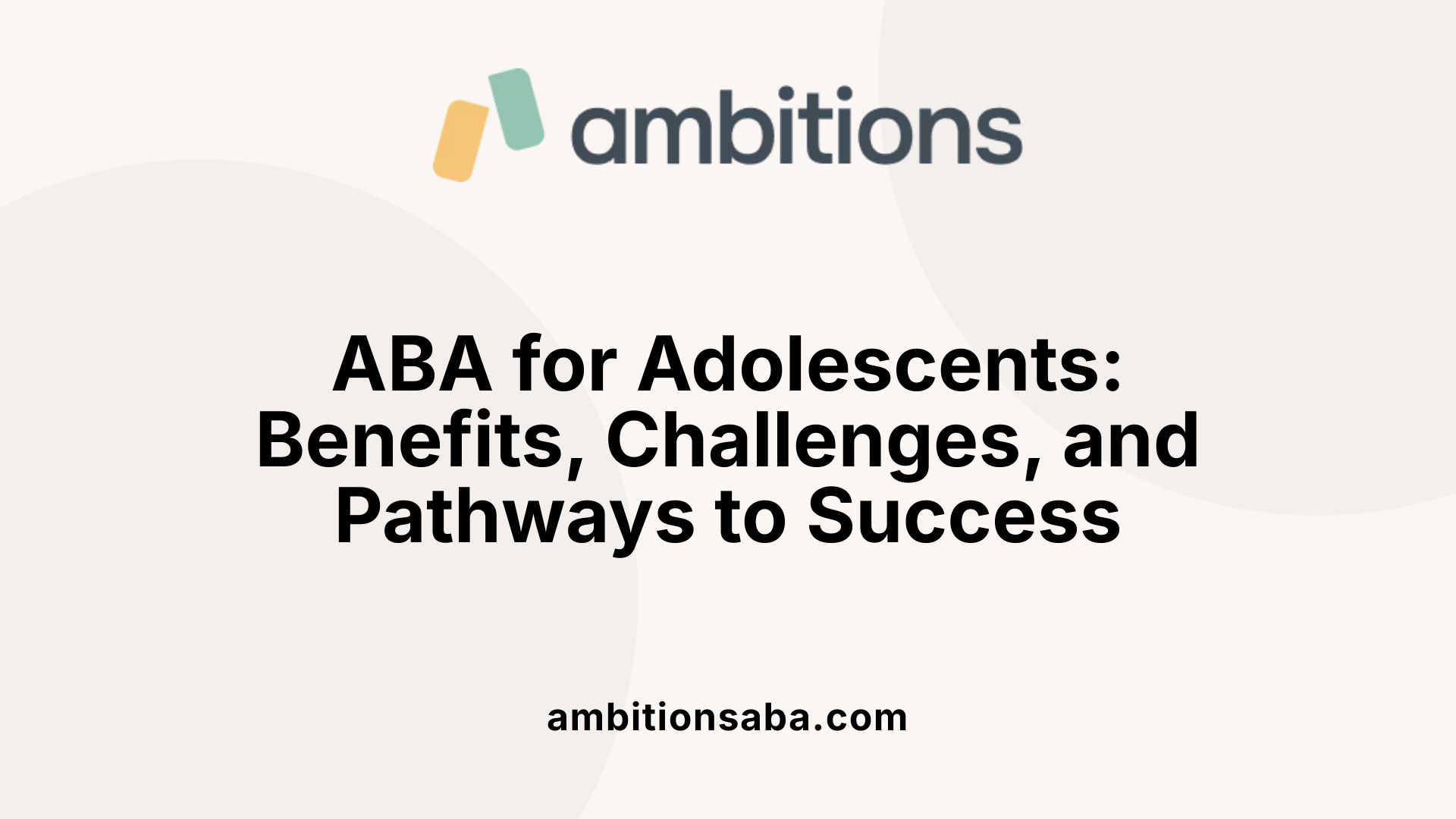Transforming Behavior Through Functional Communication Training in ABA Therapy
Understanding ABA Therapy and Its Role in Supporting Adolescents
Applied Behavior Analysis (ABA) therapy stands as a scientifically grounded approach to understanding and improving behavior. It has a rich history of over six decades in supporting individuals with autism by focusing on enhancing critical life skills and minimizing behaviors that interfere with everyday functioning. This article explores how ABA is uniquely positioned to support adolescents on the autism spectrum, emphasizing tailored intervention strategies, the roles of professionals and families, and pathways to independence.
What is ABA Therapy and How Does It Support Adolescents with Autism?

Definition and scientific basis of ABA
Applied Behavior Analysis (ABA) is a scientifically grounded therapy that studies behavior and how environmental factors influence it. It is especially effective for individuals with autism, aiming to create positive, lasting changes in socially important behaviors. This method relies heavily on research and evidence, supported by over 60 years of rigorous scientific studies demonstrating its efficacy in improving skills and reducing challenging behaviors.
Key principles: positive reinforcement, task analysis, prompting and fading
ABA employs several core principles to promote learning and behavior change. Positive reinforcement encourages repetition of desirable behaviors by rewarding them. Task analysis breaks complex skills into smaller, manageable steps for easier learning. Prompting and fading involve guiding a learner to perform a behavior and gradually reducing assistance to foster independence. These strategies, along with data-driven decision making, ensure precise and effective intervention.
Specific benefits for adolescents with autism
For adolescents with autism, ABA therapy supports development in many life areas. It improves communication, social interaction, daily living, and decision-making skills. The therapy also addresses maladaptive behaviors such as aggression or self-injury, helping teens achieve greater independence and improve their quality of life. Programs often incorporate vocational training and community-based learning to prepare teens for adult roles.
Target skills and behaviors addressed
ABA therapy for adolescents targets a wide range of skills including:
- Self-care routines (e.g., grooming, hygiene)
- Communication and social skills
- Executive functioning (e.g., planning, organizing)
- Daily living skills like cooking, money management, shopping, and transportation
- Behavioral self-regulation and problem-solving This comprehensive focus helps teens gain functional abilities essential for autonomous living.
Individualization of therapy plans
ABA plans are tailored to each adolescent's unique strengths, challenges, and goals. Intensive therapy, often over 20 hours per week, is thoughtfully adjusted over time based on ongoing progress monitoring. Involving families and educators ensures consistency across settings, enhancing the effectiveness of interventions. This personalization maximizes the potential for meaningful, durable outcomes in each teen's life.
Who Provides ABA Therapy and How Are Services Delivered to Adolescents?
Who Typically Provides ABA Therapy?
ABA therapy is primarily delivered by qualified professionals certified by the Behavior Analyst Certification Board (BACB). These include Board Certified Behavior Analysts (BCBAs), who hold advanced degrees and can design and oversee treatment programs. Supporting them are Board Certified Assistant Behavior Analysts (BCaBAs) and Registered Behavior Technicians (RBTs), who provide direct therapy under supervision.
In What Settings Is ABA Therapy Delivered?
ABA services are versatile and can be delivered across various settings to address the learner’s needs effectively. Common environments include:
- Home: Allows therapy in a familiar space, improving comfort and generalization.
- School: Integrates ABA with educational goals and classroom routines.
- Community: Provides real-world practice for daily living and social skills.
How Are Services Delivered?
Service delivery modes vary to ensure accessibility and convenience, including:
- In-Person Sessions: Traditional one-on-one or group therapy conducted face-to-face.
- Telehealth: Remote delivery of ABA therapy via videoconferencing platforms has become increasingly important. This mode facilitates real-time coaching, behavior observation, and data collection, particularly benefitting families in rural or underserved areas.
What Role Do Parents and Families Play?
Parents and family members are integral to effective ABA therapy. They participate in training programs to learn ABA strategies, enabling them to extend treatment benefits into everyday life. Their involvement fosters consistency across settings and reinforces learning.
Why Is Ethical Practice Important?
All practitioners adhere strictly to ethical standards established by the BACB. This commitment ensures professional integrity, respect for client dignity, confidentiality, and evidence-based treatment planning.
The synergy between qualified providers, flexible delivery methods, active family participation, and strong ethical practices creates a robust model of ABA service delivery that supports adolescents with autism in achieving meaningful, lasting improvements.
Core ABA Strategies for Supporting Adolescents

What are the effective ABA intervention strategies for adolescents with autism?
Applied Behavior Analysis (ABA) employs several core strategies tailored to meet the unique learning needs of adolescents with autism. These strategies emphasize skill development across communication, social interaction, and daily living activities.
Discrete Trial Training (DTT)
DTT is a structured approach that breaks down skills into small, teachable steps. Using repeated trials, clear prompts, and immediate reinforcement, adolescents learn targeted behaviors incrementally.
Natural Environment Teaching (NET)
NET embeds learning opportunities into everyday environments. This strategy encourages adolescents to practice skills in real-life contexts, promoting generalization and spontaneous use.
Pivotal Response Training (PRT)
PRT focuses on pivotal areas like motivation and self-initiation. By enhancing these core behaviors, PRT fosters broader improvements in communication and social engagement.
Verbal Behavior Therapy (VBMAPP)
VBMAPP assesses and teaches language skills using principles that emphasize verbal communication's functional aspects. This approach supports adolescents in developing meaningful conversational abilities.
Functional Communication Training (FCT)
FCT teaches alternative communication methods to replace challenging behaviors. Adolescents learn more effective ways to express needs and desires, reducing frustration and behavioral issues.
Play-Based Therapy and Self-Regulation Techniques
These strategies incorporate naturalistic play to develop social skills and employ self-regulation methods to help teens manage emotions and behaviors effectively.
Each method employs techniques such as positive reinforcement, prompting, fading, and modeling to maximize learning. ABA programs for teens often include ongoing progress monitoring and collaboration with families and educators to ensure skill generalization and consistency.
Life Skills Development Through ABA for Teens
What is Applied Behavior Analysis (ABA) therapy and how is it used to support individuals with autism?
ABA therapy is an evidence-based, structured approach tailored to help teens with autism develop essential daily living skills. It involves teaching self-care routines, effective communication, social interaction, decision-making, cooking, money management, shopping, room organization, and transportation skills.
How does ABA enhance communication and social interaction among teens?
Communication and social skills are improved through targeted strategies such as modeling, prompting, and discrete trial training. These methods encourage positive social behaviors and help teens express themselves effectively.
What decision-making and organizational skills are taught through ABA?
Decision-making and organizational skills are cultivated using task analysis and self-management techniques. Teens learn to break down complex tasks into manageable steps and practice making choices that support their independence.
How does ABA support transportation and community independence training?
ABA incorporates community-based learning and vocational training to prepare teens for navigating transportation systems and engaging safely in their communities. This fosters greater autonomy and readiness for adult roles.
What teaching strategies does ABA use to develop these life skills?
ABA utilizes positive reinforcement to encourage desired behaviors, task analysis to simplify skills into teachable parts, prompting and fading to build independence, and modeling to demonstrate behaviors. Ongoing progress monitoring ensures consistent growth, with collaboration from family and educators to maintain skill application in various settings.
Effective ABA programs empower teens with autism to achieve improved quality of life and successful transitions into adult independence.
Incorporating Vocational and Community Skills in ABA Programs

Preparing Teens for Adult Employment
ABA programs integrate vocational training to equip teens with autism for adult employment. These sessions focus on building job-related skills such as task completion, workplace communication, and time management. Utilizing methods like discrete trial training and task analysis, teens learn to navigate work environments more effectively.
Community Integration and Social Participation
Community participation is a core component of ABA therapy for adolescents. Programs encourage engagement in social and recreational activities within community settings, fostering social skills, independence, and decision-making abilities. This supports meaningful inclusion beyond the therapy context.
Collaboration with Educators and Vocational Trainers
Successful vocational and community skill development in ABA involves close cooperation with educators and vocational trainers. This teamwork ensures that learning is consistent across school, therapy, and community environments, providing teens with comprehensive support and facilitating smoother transitions.
Role of Community-Based Learning
ABA therapies incorporate community-based learning experiences, such as shopping, transportation training, and using public services. These real-world contexts enable teens to practice and generalize skills, improving adaptability and confidence in everyday life.
Outcomes Related to Independence and Quality of Life
Incorporating vocational and community skills fosters greater independence among teens with autism. Outcomes include improved self-care, better social interactions, and successful transitions into adult roles. Teens demonstrate enhanced quality of life by gaining skills necessary for employment, social engagement, and overall autonomy.
Benefits and Challenges of ABA Therapy for Adolescents

What are the main benefits and challenges of ABA therapy for individuals with autism?
Applied Behavior Analysis (ABA) therapy provides a range of benefits for adolescents with autism, primarily by improving communication and social skills. Through techniques such as positive reinforcement, discrete trial training, and naturalistic teaching, ABA helps teens develop essential abilities for daily living, including self-care, decision-making, and social interaction.
Greater independence is another major advantage of ABA therapy. By focusing on individualized goals like money management, transportation, and vocational training, adolescents are better prepared for adult roles and responsibilities. Academic success often improves as ABA methods are integrated with educational plans, enhancing attention, memory, and executive functioning.
However, ABA therapy does come with challenges. The intensity of treatment—often requiring 20 or more hours per week—can be demanding for both teens and families. Access to qualified therapists and resources may be limited, especially across different regions. Resistance to change is another hurdle, as some individuals may find structured routines or repetitive drills difficult. These challenges call for gradual transitions and collaboration with families and educators to ensure therapy is well-tolerated and effective.
Consistent support from trained professionals and caregivers is crucial for the success of ABA programs. Ethical considerations are also important, with certified practitioners upholding standards that respect individual preferences and cultural backgrounds. Balancing therapy goals with the teen’s unique strengths and interests helps maintain motivation and promotes positive outcomes.
In summary, ABA offers substantial improvements in communication, social skills, independence, and academic performance for adolescents with autism. Despite its demands and potential barriers, with personalized approaches and ethical delivery, ABA remains a powerful tool to enhance quality of life and foster successful transitions to adulthood.
The Role of Families in Supporting ABA Therapy
Parent training and involvement
Parents and family members play a vital role in ABA therapy, especially for adolescents with autism. Professional ABA practitioners provide specialized training programs that empower parents to effectively implement ABA strategies at home. This involvement not only boosts treatment progress but also helps parents become confident facilitators of their child's learning.
Extending learned behaviors to home and community
ABA skills taught during therapy sessions need reinforcement beyond clinical settings. Families help generalize and maintain these behaviors by applying learned techniques in everyday environments such as home and community. This extension supports the child's ability to use new skills independently across various situations.
Collaboration between families and professionals
Successful ABA interventions rely on close collaboration between certified ABA professionals—such as BCBAs—and families. Regular communication ensures that goals align with the adolescent's evolving needs, and that strategies remain relevant and effective. This partnership fosters personalized programming and smooth transitions between learning settings.
Consistency across settings to maximize efficacy
To maximize the benefits of ABA therapy, consistency is key. Families work alongside therapists and educators to maintain uniform approaches across home, school, and community settings. Such consistency helps reduce confusion for the adolescent and promotes lasting behavioral improvements.
Support networks and resources for families
Families involved in ABA therapy often benefit from connections to support groups, educational resources, and community services. These networks provide valuable guidance, emotional encouragement, and practical tools that enhance the overall success of therapy and family wellbeing.
Who typically provides ABA therapy and how are these services delivered?
Parent involvement is crucial, with training provided to enable the implementation of ABA methods at home. ABA services are delivered by credentialed professionals certified by the Behavior Analyst Certification Board (BACB), including BCBAs and RBTs, who work best when supported by families. Collaborations ensure that learning is consistent and generalizes across settings, increasing treatment efficacy for adolescents.
| Aspect | Detail | Impact on Therapy |
|---|---|---|
| Parent Training | Parents receive structured training to apply ABA strategies effectively | Increases skill generalization and treatment success |
| Family-Professional Collaboration | Continuous communication and joint goal setting | Personalizes therapy and supports adolescent progress |
| Consistency Across Settings | Unified ABA approach at home, school, and community | Enhances behavioral retention and reduces confusion |
| Support Networks | Access to support groups and educational resources | Provides emotional and practical assistance to families |
| ABA Service Delivery | Conducted by certified ABA professionals with family involvement | Ensures evidence-based, ethical, and individualized intervention |
Research and Professional Standards in ABA for Adolescents
What scientific evidence supports ABA efficacy?
Applied Behavior Analysis (ABA) is backed by over 60 years of rigorous scientific research demonstrating its effectiveness. Studies reveal that intensive ABA therapy, often involving 25 to 40 hours per week over multiple years, leads to significant improvements in intellectual functioning, language development, daily living skills, and social functioning. These outcomes are seen across the lifespan, including adolescence, where ABA supports skill-building in communication, social interaction, and executive functioning.
What certification and ethical standards govern ABA practitioners?
ABA practitioners are certified through the Behavior Analyst Certification Board (BACB), holding credentials such as Board Certified Behavior Analysts (BCBAs), Board Certified Assistant Behavior Analysts (BCaBAs), or Registered Behavior Technicians (RBTs). This certification process ensures advanced education, training, and adherence to a strict code of ethics, guaranteeing that professionals deliver high-quality, ethical services tailored to each adolescent's unique needs.
Why are research-based interventions critical in ABA service delivery?
ABA's foundation in scientific research ensures that interventions are both effective and responsive to the individual. For adolescents with autism, applying evidence-based approaches means therapies emphasize teaching socially significant skills while reducing disruptive behaviors. Research-based methods like Discrete Trial Training (DTT), Pivotal Response Training (PRT), and Natural Environment Teaching (NET) have proven success, guiding therapists in creating beneficial, sustainable outcomes.
How does ongoing professional development support quality improvement?
A robust clinical service model involves continuous professional development and research integration. This ecosystem enables practitioners to refine techniques, incorporate new scientific findings, and improve protocols for better outcomes. Such dedication to lifelong learning ensures ABA programs evolve to meet current best practices and maintain high standards of care, directly benefiting adolescent clients.
What role do centers like NECC play in advancing ABA?
Centers such as the New England Center for Children (NECC) demonstrate a strong commitment to evidence-based practices in autism education. NECC contributes to advancing ABA by integrating research into clinical practice and supporting professional training. Their work exemplifies how strategic collaboration between research and service delivery can enhance therapy effectiveness for adolescents, fostering advancements that raise the overall standard of ABA treatment.
Tailoring ABA to Meet Individual Needs of Adolescents

Personalization Based on Strengths and Challenges
ABA therapy for adolescents is carefully tailored to align with each individual's unique strengths and challenges. This customization ensures that interventions address specific needs, fostering skill development in communication, social interaction, and daily living.
Flexible Implementation Across Environments
Therapy is delivered flexibly across various settings such as home, school, and community environments. This adaptability promotes consistency and helps generalize learned behaviors beyond therapy sessions.
Data-Driven Decision Making and Progress Monitoring
Continual monitoring of progress through data collection guides clinical decisions. Adjustments in strategies and goals are made based on quantitative outcomes, ensuring that the therapy remains effective and dynamic.
Incorporating Interests to Enhance Motivation
Integrating an adolescent’s personal interests into ABA activities boosts engagement and motivation. This approach not only supports learning but also makes therapy rewarding, encouraging active participation.
Adjusting Therapy Intensity and Focus Over Time
Therapy intensity and targets evolve with the adolescent’s growth and development. Gradual transitions in focus areas and hours of intervention respond to changing needs, promoting independence and preparing for adult roles.
Logistical Considerations: Making ABA Accessible and Effective for Teens
What are the scheduling and intensity recommendations for ABA therapy in teens?
ABA therapy for teens with autism is most effective when tailored to individual needs, with sessions scheduled regularly to encourage skill acquisition and maintenance. While early intensive ABA often requires 20 or more hours per week, teen programs may vary based on developmental goals and existing skills. Consistent, ongoing therapy balanced with academic and social activities supports greater independence and quality of life.
How do telehealth and hybrid delivery models support ABA therapy?
The use of telehealth and hybrid models—combining in-person and virtual sessions—has increased accessibility for families, especially when transportation or local service availability is limited. These flexible approaches enable therapists to coach families and educators remotely, helping maintain consistent intervention across environments and ensuring continuity of care.
Why is coordination among schools, families, and therapists important?
Effective ABA delivery requires close collaboration between families, schools, and therapists. This team approach ensures consistency in applying strategies across settings, such as home and classroom, reinforcing learning. Frequent communication and training empower parents and educators to support skills like decision-making, social interaction, and daily living tasks.
What resources and insurance considerations affect ABA therapy accessibility?
Resource availability, including qualified practitioners such as Board Certified Behavior Analysts (BCBAs), affects the frequency and quality of ABA services. Insurance coverage for ABA varies but is often mandated when medically necessary, helping families afford therapy programs. Navigating insurance policies and securing funding remain critical logistical factors.
How are barriers to consistent ABA delivery addressed?
Challenges such as resistance to change or inconsistent therapy application are managed through gradual transitions, individualized task analysis, and ongoing progress monitoring. Working collaboratively with families and educators to create supportive environments enhances therapy effectiveness and helps reduce disruptions in service.
| Logistical Aspect | Key Considerations | Impact on Therapy Delivery |
|---|---|---|
| Scheduling & Intensity | Individualized session frequency and duration | Supports sustained developmental gains |
| Telehealth & Hybrid Models | Virtual coaching complements in-person therapy | Increases access and continuity of services |
| Coordination Among Stakeholders | Family, school, and therapist collaboration | Ensures strategy consistency and skill generalization |
| Resource & Insurance Availability | Access to certified professionals and coverage | Influences affordability and therapy quality |
| Addressing Barriers | Managing resistance and inconsistent implementation | Enhances motivation and therapy adherence |
Supporting Adolescents Through Evidence-Based ABA Practices
ABA therapy offers a robust, research-backed framework for supporting adolescents on the autism spectrum by fostering essential communication, social, and daily living skills critical for independent adult life. The effectiveness of ABA hinges on qualified practitioners, active family involvement, individualized program design, and adaptable service delivery methods. Despite challenges such as therapy intensity and accessibility, ongoing advances in professional standards and technology, including telehealth, are expanding opportunities for high-quality ABA interventions. By embracing tailored approaches that respect each adolescent’s unique needs and strengths, caregivers and professionals can maximize developmental gains, ultimately empowering teens with autism to lead fuller, more independent lives.
References
- A Treatment Summary of Applied Behavior Analysis
- The Pillars of Effective Applied Behavioral Analysis (ABA) ...
- The Role of Applied Behavior Analysis (ABA) in Autism ...
- ABA Therapy for Teens: Building Independence
- Applied Behavior Analysis (ABA)
- Applied Behavior Analysis (ABA)
- The Controversy Around ABA
- Patient Outcomes After Applied Behavior Analysis for ...
- 6 Benefits of ABA Therapy for Children with Autism

